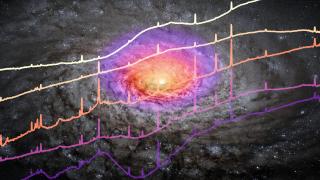Bibcode
Ramos Almeida, C.; Alonso-Herrero, A.; Esquej, P.; González-Martín, O.; Riffel, R. A.; García-Bernete, I.; Rodríguez Espinosa, J. M.; Packham, C.; Levenson, N. A.; Roche, P.; Díaz-Santos, T.; Aretxaga, I.; Álvarez, C.
Bibliographical reference
Monthly Notices of the Royal Astronomical Society, Volume 445, Issue 2, p.1130-1143
Advertised on:
12
2014
Citations
36
Refereed citations
35
Description
We present mid-infrared (MIR) imaging and spectroscopic data of the
Seyfert 2 galaxy Mrk 1066 obtained with CanariCam (CC) on the 10.4-m
Gran Telescopio CANARIAS (GTC). The galaxy was observed in imaging mode
with an angular resolution of 0.24 arcsec (54 pc) in the Si-2 filter
(8.7 μm). The image reveals a series of star-forming knots within the
central ˜400 pc, after subtracting the dominant active galactic
nucleus (AGN) component. We also subtracted this AGN unresolved
component from the 8-13 μm spectra of the knots and the nucleus, and
measured equivalent widths (EWs) of the 11.3 μm polycyclic aromatic
hydrocarbon (PAH) feature which are typical of pure starburst galaxies.
This EW is larger in the nucleus than in the knots, confirming that, at
least in the case of Mrk 1066, the AGN dilutes, rather than destroys,
the molecules responsible for the 11.3 μm PAH emission. By comparing
the nuclear GTC/CC spectrum with the Spitzer/Infrared Spectrograph (IRS)
spectrum of the galaxy, we find that the AGN component that dominates
the continuum emission at λ < 15 μm on scales of ˜60
pc (90-100 per cent) decreases to 35-50 per cent when the emission of
the central ˜830 pc is considered. On the other hand, the AGN
contribution dominates the 15-25 μm emission (75 per cent) on the
scales probed by Spitzer/IRS. We reproduced the nuclear infrared
emission of the galaxy with clumpy torus models, and derived a torus gas
mass of 2 × 105 M⊙, contained in a
clumpy structure of ˜2 pc radius and with a column density
compatible with Mrk 1066 being a Compton-thick candidate, in agreement
with X-ray observations. We find a good match between the MIR morphology
of Mrk 1066 and the extended Paβ, Brγ and [O III]
λ5007 emission. This coincidence implies that the 8.7 μm
emission is probing star formation, dust in the narrow-line region and
the oval structure previously detected in the near-infrared. On the
other hand, the Chandra soft X-ray morphology does not match any of the
previous, contrary to what it is generally assumed for Seyfert galaxies.
A thermal origin for the soft X-ray emission, rather than AGN
photoionization, is suggested by the different data analysed here.
Related projects

Starbursts in Galaxies GEFE
Starsbursts play a key role in the cosmic evolution of galaxies, and thus in the star formation (SF) history of the universe, the production of metals, and the feedback coupling galaxies with the cosmic web. Extreme SF conditions prevail early on during the formation of the first stars and galaxies, therefore, the starburst phenomenon constitutes a
Casiana
Muñoz Tuñón

Nuclear Activity in Galaxies: a 3D Perspective from the Nucleus to the Outskirts
This project consists of two main research lines. First, the study of quasar-driven outflows in luminous and nearby obscured active galactic nuclei (AGN) and the impact that they have on their massive host galaxies (AGN feedback). To do so, we have been granted time with the Gran Telescopio CANARIAS (GTC) in the optical and near-infrared ranges
Cristina
Ramos Almeida